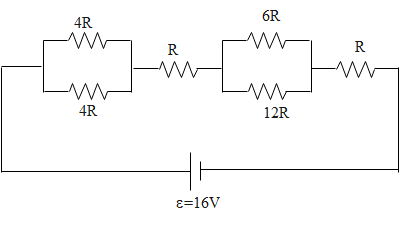
Answer
440.1k+ views
Hint: For the given circuit, first we need to find out the equivalent resistance for the given combination of resistances. Then by inserting the equivalent resistance in the formula for the power consumed in an electrical circuit, we can find out the values of R.
Formula Used
The power consumed by an electrical circuit is given as follows:
\[P = \dfrac{{{V^2}}}{R}\]
Complete step by step answer:
We are given a resistive network as shown in the diagram. Let us find out the equivalent resistance for the given combination of resistances.
The first two resistances are connected in parallel with each other. If R’ is their equivalent resistance then it can be obtained in the following way.
$R' = \dfrac{{4R \times 4R}}{{4R + 4R}} = \dfrac{{4R \times 4R}}{{8R}} = 2R$
Similarly, if R’’ is the equivalent resistance of the second set of resistance connected in parallel with each other then it can be obtained in the following way.
$R'' = \dfrac{{6R \times 12R}}{{6R + 12R}} = \dfrac{{6R \times 12R}}{{18R}} = 4R$
Now the above two equivalent resistances are connected in series with other resistance present in the circuit. Therefore, if R’’’ is the equivalent resistance of the complete circuit then it can be obtained in the following way.
$R''' = R' + R + R'' + R = 2R + R + 4R + R = 8R$
Now we are given the value of the voltage for the attached battery. Its value is given as
$\varepsilon = 16V$
The value of power is given to us which is
$P = 4W$
Now, the power consumed by this electrical circuit is given as follows:
$P = \dfrac{{{\varepsilon ^2}}}{{R'''}}$
Now inserting the known values, we obtain
$
4 = \dfrac{{{{16}^2}}}{{8R}} \\
\therefore R = \dfrac{{{{16}^2}}}{{8 \times 4}} = 8\Omega \\
$
This is the required value of R. Hence, the required answer is option A.
Note:
It should be noted that when we take a parallel combination then the equivalent resistance is smaller than the individual resistances attached in parallel with each other. But for the resistances connected in series, the equivalent resistance adds up and is greater than the individual resistances attached in series with each other.
Formula Used
The power consumed by an electrical circuit is given as follows:
\[P = \dfrac{{{V^2}}}{R}\]
Complete step by step answer:
We are given a resistive network as shown in the diagram. Let us find out the equivalent resistance for the given combination of resistances.
The first two resistances are connected in parallel with each other. If R’ is their equivalent resistance then it can be obtained in the following way.
$R' = \dfrac{{4R \times 4R}}{{4R + 4R}} = \dfrac{{4R \times 4R}}{{8R}} = 2R$
Similarly, if R’’ is the equivalent resistance of the second set of resistance connected in parallel with each other then it can be obtained in the following way.
$R'' = \dfrac{{6R \times 12R}}{{6R + 12R}} = \dfrac{{6R \times 12R}}{{18R}} = 4R$
Now the above two equivalent resistances are connected in series with other resistance present in the circuit. Therefore, if R’’’ is the equivalent resistance of the complete circuit then it can be obtained in the following way.
$R''' = R' + R + R'' + R = 2R + R + 4R + R = 8R$
Now we are given the value of the voltage for the attached battery. Its value is given as
$\varepsilon = 16V$
The value of power is given to us which is
$P = 4W$
Now, the power consumed by this electrical circuit is given as follows:
$P = \dfrac{{{\varepsilon ^2}}}{{R'''}}$
Now inserting the known values, we obtain
$
4 = \dfrac{{{{16}^2}}}{{8R}} \\
\therefore R = \dfrac{{{{16}^2}}}{{8 \times 4}} = 8\Omega \\
$
This is the required value of R. Hence, the required answer is option A.
Note:
It should be noted that when we take a parallel combination then the equivalent resistance is smaller than the individual resistances attached in parallel with each other. But for the resistances connected in series, the equivalent resistance adds up and is greater than the individual resistances attached in series with each other.
Recently Updated Pages
what is the correct chronological order of the following class 10 social science CBSE

Which of the following was not the actual cause for class 10 social science CBSE

Which of the following statements is not correct A class 10 social science CBSE

Which of the following leaders was not present in the class 10 social science CBSE

Garampani Sanctuary is located at A Diphu Assam B Gangtok class 10 social science CBSE

Which one of the following places is not covered by class 10 social science CBSE

Trending doubts
Which are the Top 10 Largest Countries of the World?

What percentage of the solar systems mass is found class 8 physics CBSE

Fill the blanks with the suitable prepositions 1 The class 9 english CBSE

The Equation xxx + 2 is Satisfied when x is Equal to Class 10 Maths

How do you graph the function fx 4x class 9 maths CBSE

Give 10 examples for herbs , shrubs , climbers , creepers

Difference Between Plant Cell and Animal Cell

Why is there a time difference of about 5 hours between class 10 social science CBSE

Difference between Prokaryotic cell and Eukaryotic class 11 biology CBSE




